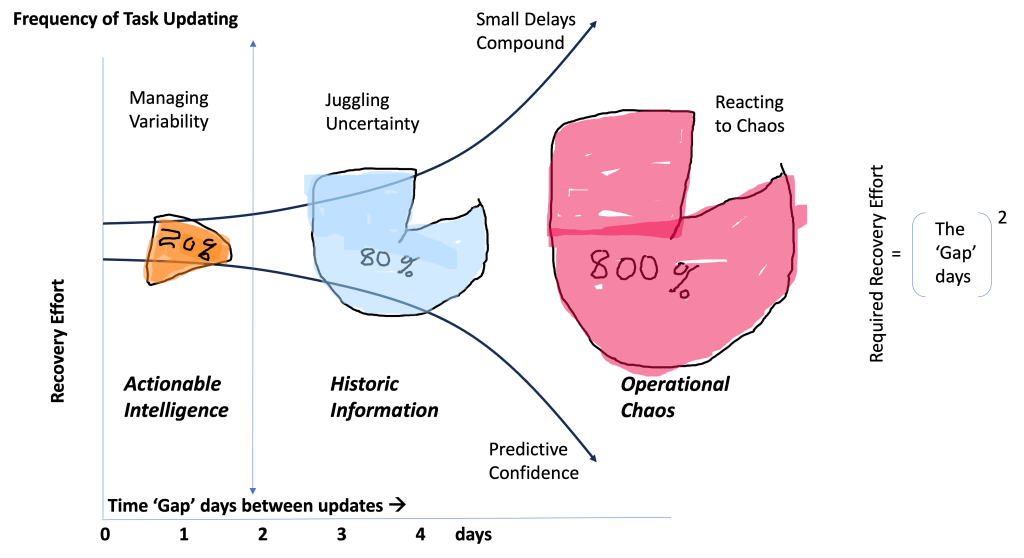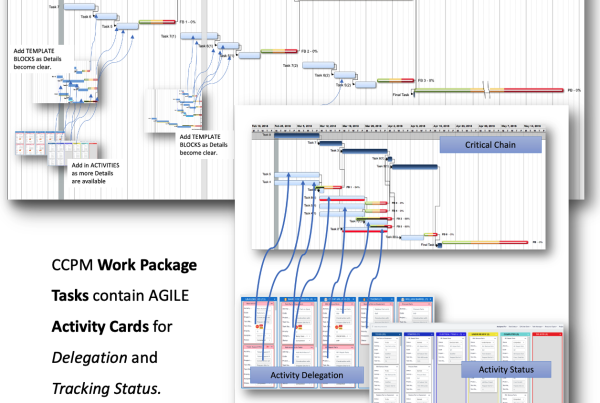Infrequent updates are a significant obstacle in pursuing project success, regardless of the total project duration.
Delaying Task updates by 5 days to two weeks has substantial consequences, potentially leading to inaccurate predictions, mainly regarding Resourcing and other critical predictive metrics. To address this issue, project managers should focus on the three leading indicators of project success.
Three Key Indicators of Project Success
1. High Frequency of Task Updating (less than 2 days): Address your Problems early! Problems compound if you don’t. The Last Update indicator emphasizes the importance of real-time intelligence. When project tasks are updated frequently (within two days or less), we ensure that project data is current and practically actionable for decision-making. This is the difference between – historic Information and real-time Intelligence in decision-making. Reviewing outdated information is to make decisions relative to the past but expecting a predicted future to evolve.
With delayed updating, Problems Compound and the prediction error dramatically increase. Proactive Management is lost, and timely intervention is compromised. Expect Reactive Management by delaying Task updating. For those who love figures, problems compound by the square of the update delay (days). See Figure 1.

Fig. 1
2. Are Remaining Durations Intelligently Updated?
Lots of Notes (Nt) added to Project Tasks and the applying Reason Codes (RC) for Delays: Comprehensive Notes and the use of Reason Codes signal that resources are engaged and actively thinking about the project and issues related to delays. Nt and RC provide context and explanations for project updates, creating a deeper understanding of project progress and challenges. The Nts’ and RCs’ history is critical for analysis and establishing continuous improvement and project modulation. AI analysis of Reason Codes and Notes provides valuable insights for effective continuous improvement.
3. Wide Span of Decentralized Participation in Updating: Project success is not the sole responsibility of a select few removed from the actual operations. Engaging a diverse team in task updates is a key indicator of high method adoption, understanding, and participation in the project’s success. Different perspectives and expertise contribute to a more comprehensive understanding of the project and its complexities.
The Role of the “Last Modified” Date Column.
Is the information up to date? The “Last Modified” date column serves as a visual representation of our engagement metrics. It indicates when tasks were last updated and when notes and reason codes were added for delayed tasks. By paying attention to this column, we gain insights into the timeliness of updates and the overall health of our projects.
Conclusion
In conclusion, this guide underscores the critical importance of Engagement in achieving project success. By ensuring a high frequency of task updating, encouraging comprehensive notes and reason codes, and fostering decentralized participation in updates, we set the stage for more successful projects. Monitoring the “Last Modified” column allows us to track and measure the quality of reliable Intelligence and not historical information.
By collectively adhering to these three engagement metrics, we increase the likelihood of accurate resource allocation, project success, and customer satisfaction.



